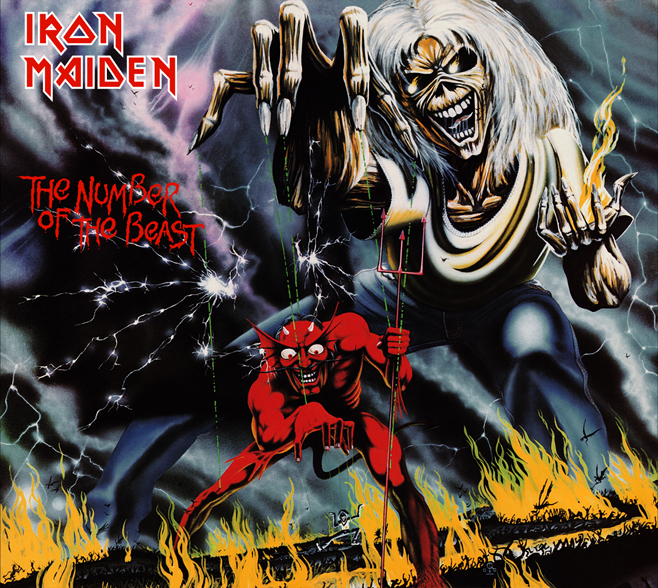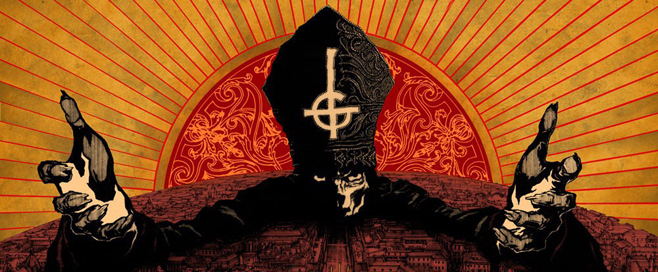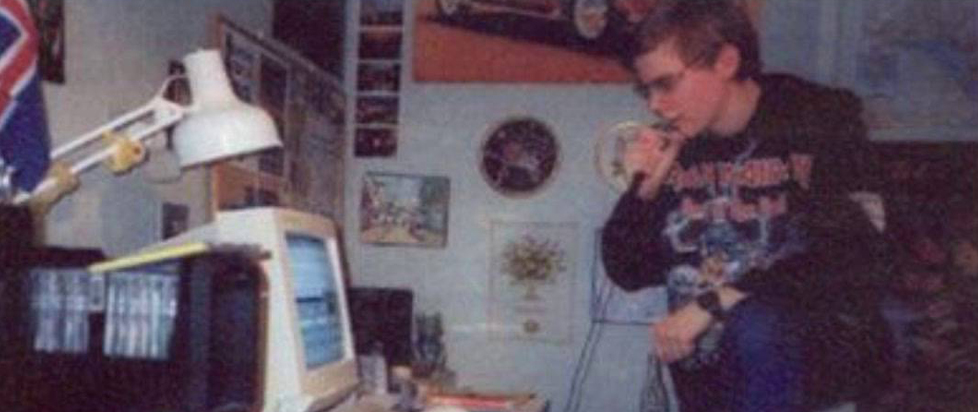
Hail Satan!
The Burnt Offering is where Stu Horvath thinks too much in public so he can live a quieter life in private.
———
Hundreds of people were singing, “Come together / Together as a one / Come together for Lucifer’s son.” Papa, his pallid rictus illuminated with red light, pantomimed the movements of a choral conductor as the church organ piped out the melody of “Monstrance Clock.” The audience raised their hands in the sign of the horn and swayed in time.
This was the end of Ghost B.C.’s (the B.C. is silent) set at Webster Hall in New York City. To my left was a middle aged guy with thinning long blonde hair wearing a KISS tank top. He was standing with his hard-faced girlfriend. To my right was a nondescript college kid in a polo shirt. The enormous fellow in front of me was wearing a scally cap and looked like he’d be more at home at a Mighty Mighty Bostones concert. Behind me was a fratty guy who yelled “Satan!” at the top of his lungs every few minutes, like he had some kind of infernal Tourette’s. His friend counted off the time signature of every song just as frequently.
And then there was my pal Shawn, who looks like a lumberjack, and me, in a dress shirt and pinstriped jacket. It was a diverse crowd, back by the bar, but every one of us knew all the words to the songs.
———
When I was in San Francisco back in March of 2013, I went record shopping with Peter Rubin, my friend and editor at Wired. One of the LPs I bought was the new release from Nails, Abandon All Life. I showed the cover to Peter – a red and black swirl of fire and hooded figures – and said, “Now that is some evil looking shit.”
Peter surprised me with a question: “What’s with you and the evil? You aren’t evil. Everyone I know who likes stuff like that is actually really nice. What is the fascination?”
I didn’t have a good answer.
———
I grew up during the Satanic Panic of the 1980s. The panic started thanks to books (now discredited) like The Satan Seller, by Mike Warnke, and Michelle Remembers, by Lawrence Pazder & Michelle Smith, which claimed there was a vast and secret network of Satanic cults corrupting the youth of America and performing rituals involving human sacrifice. Allegations of abuse and murder sparked dozens of investigations that garnered national media attention but never turned up any actual crimes.
Bands got caught up in similar controversies. Judas Priest was unsuccessfully sued in Reno, Nevada, for inspiring the suicide attempts of two men by allegedly planting subliminal messages in their album Stained Class. Ozzy Osbourne has been plagued by lawsuits over his career, most famously over a suicide that took place while his song “Suicide Solution” was playing.
I didn’t know about any of this at the time, of course. I just knew that the cover of Iron Maiden’s Number of the Beast was awesome and I wasn’t allowed to have it. That, naturally, made me want it even more. Heavy metal seemed to be the appropriate soundtrack for a childhood filled with comic books and videogames and monster movies and Dungeons & Dragons. Those things all had stigmas attached to them – they made you weird, they made you an outsider. Metal made liking those things, if not safer, at least cooler.

Until the 90s and the rise of Norwegian black metal and its sordid slew of church burnings, suicides and murder, there weren’t many explicit connections between Satanism and heavy metal. The devil is in the stage dressing, sure, but more often than not, he is still the bad guy. Judas Priest’s “Painkiller,” for instance, describes an avenging angel saving mankind and Black Sabbath’s “War Pigs” is about as convincing a repudiation of the devil that I can think of. “Suicide Solution,” if you bother to read the lyrics, is actually about the destructive power of alcohol, not an encouragement to self-murder. King Diamond, a self-professed Satanist, only believes in the devil as a philosophical concept, not as an actual entity.
Even the murder of guitarist Euronymous, of the Norwegian black metal band Mayhem, in 1993 smacks more of general misanthropy rooted in money and power than the occult. Ghost, on the other hand, seem rather serious about Satan.
Their first album, Opus Eponymous, obsesses over sex and diabolism. It all seems like good theater at first – the singer, Papa, dressed as an undead pope, the band of Nameless Ghouls all hooded and masked and anonymous. Papa’s voice is no black metal rasp, either, but is actually soft and, I daresay, sweet. The music itself oscillates from hard riffs to catchy pop hooks that harken as much to the Beach Boys as they do Blue Oyster Cult. The bonus track is a cover of the Beatles’ “Here Comes the Sun.”
The new album, Infestissumam (Latin for hostile, and used by the band in reference to the Antichrist), is even brighter, poppier and includes an Abba cover. As if they were not cartoonishly profane enough, the band’s merch shop even offers a pricey set of Ghost-themed sex toys.
A hint of anxiety creeps in when the lyrics aren’t so bombastically Satanic. It worries me when they refer to the devil as the Master and offhandedly reference things like altar beds. Maybe they aren’t kidding? It is all a bit post-modern, granted, but it also seems so earnest. I have no way of knowing if the band devoutly worships Satan, but their farce of a rock band worshiping Satan certainly seems to be in the service of something they take very seriously.
The dark imagery of metal is meant to provoke, to shock a complacent mind into thinking along lines that would be more comfortable to ignore. How else do you explain the dissonance when you learn that so many violent-seeming metal bands have members who are practicing vegetarians and vegans? And if metal appeals to people who have a certain dissatisfaction with what is accepted as normal, then what better a hero to claim than Satan, the rebel angel who tricked Man into eating from the Tree of Knowledge? It is telling, perhaps, that most of the metal heads I know (including the very spooky King Diamond) are also atheists.

After the first two songs, Papa finally gets to address the audience. Miter in hand, he exclaims, “Good evening, New York City!” and the bass thunders into the beginning of “Con Clavi Con Dio.” The crowd bellows along with the opening lyrics: “Lucifer! / We are here / For your praise / Evil One.” Papa’s pointing and gesticulating makes it all feel so inclusive. And electric. Even watching the crummy YouTube videos two days later makes my pulse quicken.
We. We are here. There is nothing separating the congregation from the preacher here.
A Nameless Ghoul from Ghost said in an interview with Noisey that they are “trying to create a sphere for everybody to step into and…either become or pretend that you are worshiping the devil for an hour.”
As weird and diverse as that crowd was, we did have one thing in common: Ghost. And it did feel like a kind of religious service (well, an unusually loud one, anyway). It felt positive; even if it was a parody of spirituality, the effect of singing those songs together created something powerful. We live in a world where conventional faith is professed everywhere, but we see so little grace. Perhaps we could use more Satan.
———
The Burnt Offering is a semi-regular column in which Stu Horvath thinks too much. Follow him on Twitter @StuHorvath. He saw Ghost again a few months later, with more friends, and it was also a pseudo-religious experience. He’s doing the Devil’s work and bringing a small army of people to the band’s next local show in May. Drop him a line if you’re going, too.
This story originally appeared on Medium, but it feels a lot nicer having it on Unwinnable. It also included a Spotify playlist of songs mentioned in this story, as well as a selection of other tunes with overt Satanic themes – it has since been slightly expanded.





